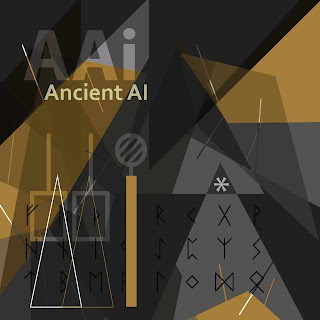Ancient AI (Liner Notes)
Side A
A1: Mxines
The sound of trains has always inspired pop music. But now machines are silent algorithms. The closest corollary to machines inspiring music is the random buzzes and clicks from electronics and things like the read/write head on a disk drive. That's what inspired the static-y rhythms on this track. The glitched sound is from the random "scrubbing" of the timeline.
A2: Ancient AI
A generative work based on one small looped MIDI file playing various synth patches and samples, and three gapped scales to be used for improvisation (its "DNA").
The tempo can be set at multiples of itself (e.g. 46/92/184) and played as layered polyrhythms. (For example, the MIDI file can loop at 92 on another sample running at 184, against another one running at 46.)
Chord Changes: G# min / A / G#min / F#min / E / C#min
The melodic layer uses four scales simultaneously, an E minor pentatonic against a C#minor, F#minor or G#minor, which lets the G and D natural clash in interesting ways with the G and D-naturals as a kind of "planned accident".
The scales are designed to create tension and release by introducing dissonant intervals through cells and tetrachords, as opposed to playing them as random free tones.
Counterpoint can also be applied, for example, bass notes or chords used strategically to define tonalities in real time, using three scales, instead of the usual "chord scale".
A3: March of the Nootropians
Working title "Morfeo". Started with a bass riff composed of three notes descending and ascending in a symmetrical fashion. There is a string quartet version of this as well and could be something I may want to explore in the future.
A4: Zed Zone
Beat layering and a repeating sax riff over which I am improvising a bass part in A Lydian, over which the following chord scale is used, a hybrid of A Lydian and an E minor pentatonic. in a harmolodic fashion. In the harmolodic universe, any note can be used, but the melodic and harmonic dissonances are resolved to some level of consonance in real-time. "Wrong" notes used in a diatonic setting are typically more difficult to resolve, as they are more vulnerable. But when everything is mostly dissonant, you can find more logic in the way the notes resolve and merge into the whole. If everything is noisy, adding more noise doesn't make it that much more noisy.
A5: Futurai
A spin-off of a project with all songs exactly one minute long, in this case 15 bars in 4/4, Tempo=60.
Chord changes are G7 /F min / C min / B dim 7
Side B
B2: Continuous Interruption
4 and 2 against 3. The stuttering ("interrupted") bass line in 3/4 is placed in context with a fairly regular 4/4 groove, and staccato piano chords 2 against 3
B4: No Place Like Zome
African mesh groove in Bb Dorian with three interlaced bass lines and ambient treatment.
B5: Alux (Duende)
A cell of 5 notes (G-Ab-B-C-G) is superimposed over a basic 4/4 beat and a G pedal point. The repeating phrase ideally will float in and out of the piece as if the sound is being carried by the wind. The piece drifts out of phase for 20 bars, then comes back in sync on a downbeat. The cell can be played manually (ideally) or can be a repeating loop in the background with volume controlled by the engineer at the mixing board. The 5-note cell generates the chords used, as well as 4 tetrachords to be used for improvisation.
B6: Night Reeds
A blues in F Phrygian
B7: Ancient Code / Alien C
A "happy accident" with a slowed-down glitch, followed by a "hidden track", comprised of layered ambient "alien" textures on C-natural. (The sound of an alien "sea")
Side D
"Matrioshka III" is somewhat of a remix from the original track on Side A. "Pandialora" is a made-up word extrapolated from "Pandora", done by adding syllables inside the word. (There must be a technical term for this in linguistics--a "spoonerism" or similar argots or "misnoming"). I almost always have working titles and was "In the Round", a synth patch I used at the beginning and was removed subsequently. (It's in D Dorian on a Dmin9 chord, if you should care). "Cene Mxine" is quasi-EDM, and the title is a riff on epochs: "Holocene", "Anthropocene", 'Eocene". There's a short string quartet embedded in it towards the end using the same bass ostinato, then drifts off to a Floydian landscape, with bits of field recordings mixed in.




